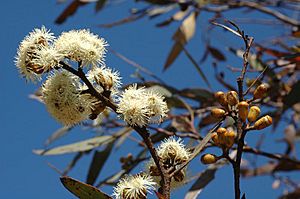Eucalyptus scyphocalyx facts for kids
Quick facts for kids Goblet mallee |
|
|---|---|
 |
|
| Buds and flowers of Eucalyptus scyphocalyx in the Australian Botanic Garden Mount Annan | |
| Scientific classification | |
| Genus: |
Eucalyptus
|
| Species: |
scyphocalyx
|
The goblet mallee (scientific name: Eucalyptus scyphocalyx) is a special type of eucalyptus tree that grows only in the southern parts of Western Australia. It's called a "goblet mallee" because of the shape of its fruit, which looks a bit like a goblet or cup! This tree has smooth bark, long, narrow leaves, and pretty creamy-white flowers.
Contents
What the Goblet Mallee Looks Like
The goblet mallee is a type of mallee, which means it's a small, bushy eucalyptus tree. It usually grows to be about 2 to 6 meters (about 6 to 20 feet) tall. It has a special woody swelling at its base called a lignotuber. This helps the plant regrow after a fire.
Its bark is smooth and can be pale brown or grey. However, older trees might have rough, peeling bark near the bottom.
Leaves and Flowers
Young goblet mallees have dull green, lance-shaped leaves. These leaves are about 5 to 8.5 centimeters (2 to 3.3 inches) long and 1 to 2 centimeters (0.4 to 0.8 inches) wide.
Adult leaves are also lance-shaped and the same green color on both sides. They are a bit longer, about 6 to 10.5 centimeters (2.4 to 4.1 inches) long and 1 to 2 centimeters (0.4 to 0.8 inches) wide. The base of the leaf tapers down to a stalk called a petiole, which is about 8 to 23 millimeters (0.3 to 0.9 inches) long.
The flower buds grow in groups of three or seven. They are found where the leaves meet the stem, on a small stalk called a peduncle. Each individual bud also has its own tiny stalk, called a pedicel.
Mature buds are shaped like a cylinder or a spindle. They are about 7 to 13 millimeters (0.3 to 0.5 inches) long and 4 to 7 millimeters (0.16 to 0.28 inches) wide. They have a cap, called an operculum, which can be shaped like a hemisphere or a cone.
The goblet mallee mostly flowers from July or September to December. Its flowers are a lovely creamy white color.
Fruit
After flowering, the plant produces a woody fruit. This fruit is a capsule that looks like a cup or a cylinder. It's about 6 to 11 millimeters (0.24 to 0.43 inches) long and 7 to 9 millimeters (0.28 to 0.35 inches) wide. The parts that open to release the seeds (called valves) are tucked below the rim of the fruit.
How the Goblet Mallee Got Its Name
The goblet mallee was first officially described in 1867 by a scientist named George Bentham. He used notes from another scientist, Ferdinand von Mueller. At first, it was considered a type of Eucalyptus dumosa.
Later, in 1929, Joseph Maiden and William Blakely decided it was special enough to be its own species. They changed its name to E. scyphocalyx.
The scientific name scyphocalyx comes from ancient Greek words. Scyphos means "cup," and it refers to the cup-like shape of the calyx (the outer part of the flower bud).
Different Types of Goblet Mallee
In 2001, two scientists, Lawrie Johnson and Donald Blaxell, found that there are two slightly different kinds of goblet mallee. These are called subspecies:
- Eucalyptus scyphocalyx subsp. scyphocalyx: This type has flower buds that grow in groups of seven.
- Eucalyptus scyphocalyx subsp. triadica: This type has flower buds that grow in groups of three.
Where the Goblet Mallee Grows
The goblet mallee is found in sandy areas in Western Australia. You can find it between towns like Jerramungup, Ravensthorpe, and Salmon Gums. These areas are in the Great Southern and Goldfields-Esperance regions of Western Australia.
The subspecies triadica has a smaller home range. It grows mainly in an area northeast of Esperance.
Is the Goblet Mallee Endangered?
The government of Western Australia, through its Department of Parks and Wildlife, has classified this eucalyptus as "not threatened." This means it's not currently at risk of disappearing.

